James Webb Space Telescope


James Webb Space Telescope (JWST) er et ubemandet amerikansk rumobservatorium og international rummission i et samarbejde mellem NASA, European Space Agency (ESA) og Canadian Space Agency (CSA).[1] Rumobservatoriet er opkaldt efter James E. Webb,[2] der var leder af NASA fra 1961 til 1968 og spillede en vigtig rolle i udviklingen af Apollo-programmet.[3][4] JWST efterfølger Hubble-rumteleskopet som NASA vigtigste strategiske rumobservatorium indenfor astrofysik.[5][6]
De væsentligste dele af JWST er bygget af Northrop Grumman[7] og består af et 6,5 meter stort spejlteleskop[8] til udforskning af ekstremt fjerne astronomiske objekter via observationer i det infrarøde spektrum. Teleskopet og måleinstrumenterne holdes på en temperatur under 50 K (-220°C).[9] JWST's specifikationer gør det muligt at foretage en række astronomiske observationer, der ikke er mulige i dag fra de eksisterende land- og rumbaserede observatorier. Et af målene med JWST er at undersøge nogle af de fjernest beliggende objekter i Universet. Sådanne objekter er de første stjerner, perioden med reionisering og dannelsen af de første galakser. Andre mål er at undersøge dannelsen af solsystemer og observere exoplaneter. JWST kan se 13,5 milliard år tilbage i tiden.[10][11]
JWST blev opsendt den 25. december 2021[12] af en Ariane 5 raket. JWST befinder sig 1,5 millioner km fra Jorden i Lagrange-punkt L2 over den side af Jorden, der vender væk fra Solen. Rummissionen er udviklet ved NASA's Goddard Space Flight Center (GSFC) i Maryland og Space Telescope Science Institute er operatør af JWST.[13]
Det første videnskabelige billede taget af teleskopet blev offentliggjort den 11. juli 2022.[14]
Økonomi
Projektet blev påbegyndt i 1996 for en opsendelse planlagt til 2007 for et budget på 500 millioner dollar.[15] JWST-projektet har været plaget af væsentlige budgetoverskridelser og forsinkelser. Efter at det i 2011 var brugt ca. 3 milliarder $, besluttede det amerikanske senat at skrotte projektet, men det blev efterfølgende besluttet at genoptage programmet, dog med en maksimal udgift på 8,8 milliarder $ pr. december 2014.[16]
Galleri
- Test af spejlene i teleskopet
- JWST's størrelse sammenlignet med Hubble-teleskopets størrelse
- Spejlet samlet i maj 2016
- JWST "pakket" med sejl, der foldes ud i rummet
- Sejlet foldes ud på Jorden
- Animation af sejlet der foldes ud i Rummet
- Billede af planeten Jupiter taget af JWST, juli 2022
- NIR-billede af skabelsens søjler taget af James Webb Space Telescope i 2022
Referencer
- ^ Meet the team: Partners and Contributors - official NASA website of James Webb Space Telescope
- ^ Witze, Alexndra (23. juli 2021). "NASA investigates renaming James Webb telescope after anti-LGBT+ claims. Some astronomers argue the flagship observatory – successor to the Hubble Space Telescope – will memorialize discrimination. Others are waiting for more evidence". Nature. 596 (7870): 15-16. doi:10.1038/d41586-021-02010-x. PMID 34302150. Hentet 23. juli 2021.
- ^ "ESA JWST Timeline". Arkiveret fra originalen 21. august 2003. Hentet 13. januar 2012.
- ^ During, John. "The James Webb Space Telescope". NASA. Arkiveret fra originalen 8. november 2022. Hentet 31. december 2011.
- ^ "About the James Webb Space Telescope". Hentet 13. januar 2012.
- ^ "How does the Webb Contrast with Hubble?". NASA. Arkiveret fra originalen 3. december 2016. Hentet 4. december 2016.
- ^ "James Webb Space Telescope". Northrop Grumman. 2017. Arkiveret fra originalen 10. februar 2017. Hentet 31. januar 2017.
- ^ "Mirrors Webb/NASA". webb.nasa.gov (engelsk). Hentet 2021-12-30.
- ^ Hubble-teleskopets afløser klarer 116 dage i vakuumfryser, ing.dk, 27. oktober 2014
- ^ Verdens mest kraftfulde rumteleskop klar til at blive samlet, ing.dk, 9. februar 2014
- ^ "A Deeper Sky | by Brian Koberlein". briankoberlein.com.
- ^ NASA's James Webb Space Telescope launches on epic mission to study early universe, Space.com, 25. december 2021, hentet 25. december 2021
- ^ "About Webb". NASA. 2019. Arkiveret fra originalen 9. februar 2022. Hentet 4. juni 2021.
- ^ Biden unveils James Webb Space Telescope's ultradeep view of the universe, 11. juli 2022, space.com
- ^ "STSCI JWST History 1996". Stsci.edu. Arkiveret fra originalen 3. februar 2014. Hentet 16. januar 2012.
- ^ "Webb telescope at risk of schedule delays, report finds, www.baltimoresun.com, 22. december 2014". Arkiveret fra originalen 17. november 2017. Hentet 30. juni 2015.
Eksterne henvisninger
Medier brugt på denne side
A rare view of the James Webb Space Telescope face-on, from the NASA Goddard cleanroom observation window.
Forfatter/Opretter: Bobarino, Licens: CC BY-SA 3.0
A comparison of the Hubble Space Telescope primary mirror with the James Webb Space Telescope primary mirror with a person for scale
James Webb Space Telescope Deployment Sequence (Nominal)
The Pillars of Creation are set off in a kaleidoscope of color in NASA’s James Webb Space Telescope’s near-infrared-light view. The pillars look like arches and spires rising out of a desert landscape, but are filled with semi-transparent gas and dust, and ever changing. This is a region where young stars are forming – or have barely burst from their dusty cocoons as they continue to form.
Newly formed stars are the scene-stealers in this Near-Infrared Camera (NIRCam) image. These are the bright red orbs that sometimes appear with eight diffraction spikes. When knots with sufficient mass form within the pillars, they begin to collapse under their own gravity, slowly heat up, and eventually begin shining brightly.
Along the edges of the pillars are wavy lines that look like lava. These are ejections from stars that are still forming. Young stars periodically shoot out supersonic jets that can interact within clouds of material, like these thick pillars of gas and dust. This sometimes also results in bow shocks, which can form wavy patterns like a boat does as it moves through water. These young stars are estimated to be only a few hundred thousand years old, and will continue to form for millions of years.
Although it may appear that near-infrared light has allowed Webb to “pierce through” the background to reveal great cosmic distances beyond the pillars, the interstellar medium stands in the way, like a drawn curtain.
This is also the reason why there are almost no distant galaxies in this view. This translucent layer of gas blocks our view of the deeper universe. Plus, dust is lit up by the collective light from the packed “party” of stars that have burst free from the pillars. It’s like standing in a well-lit room looking out a window – the interior light reflects on the pane, obscuring the scene outside and, in turn, illuminating the activity at the party inside.
Webb’s new view of the Pillars of Creation will help researchers revamp models of star formation. By identifying far more precise star populations, along with the quantities of gas and dust in the region, they will begin to build a clearer understanding of how stars form and burst out of these clouds over millions of years.
The Pillars of Creation is a small region within the vast Eagle Nebula, which lies 6,500 light-years away.
Webb’s NIRCam was built by a team at the University of Arizona and Lockheed Martin’s Advanced Technology Center.Jupiter dominates the black background of space. The image is a composite, and shows Jupiter in enhanced color, featuring the planet’s turbulent Great Red Spot, which appears white here. The planet is striated with swirling horizontal stripes of neon turquoise, periwinkle, light pink, and cream. The stripes interact and mix at their edges like cream in coffee. Along both of the poles, the planet glows in turquoise. Bright orange auroras glow just above the planet’s surface at both poles.
“We hadn’t really expected it to be this good, to be honest,” said planetary astronomer Imke de Pater, professor emerita of the University of California, Berkeley. De Pater led the observations of Jupiter with Thierry Fouchet, a professor at the Paris Observatory, as part of an international collaboration for Webb’s Early Release Science program. Webb itself is an international mission led by NASA with its partners ESA (European Space Agency) and CSA (Canadian Space Agency).
This image comes from the observatory’s Near-Infrared Camera (NIRCam), which has three specialized infrared filters that showcase details of the planet. Since infrared light is invisible to the human eye, the light has been mapped onto the visible spectrum. Generally, the longest wavelengths appear redder and the shortest wavelengths are shown as more blue. Scientists collaborated with citizen scientist Judy Schmidt to translate the Webb data into images.
In the standalone view of Jupiter, created from a composite of several images from Webb, auroras extend to high altitudes above both the northern and southern poles of Jupiter. The auroras shine in a filter that is mapped to redder colors, which also highlights light reflected from lower clouds and upper hazes. A different filter, mapped to yellows and greens, shows hazes swirling around the northern and southern poles. A third filter, mapped to blues, showcases light that is reflected from a deeper main cloud.
The Great Red Spot, a famous storm so big it could swallow Earth, appears white in these views, as do other clouds, because they are reflecting a lot of sunlight.
“The brightness here indicates high altitude – so the Great Red Spot has high-altitude hazes, as does the equatorial region,” said Heidi Hammel, Webb interdisciplinary scientist for solar system observations and vice president for science at AURA. “The numerous bright white ‘spots’ and ‘streaks’ are likely very high-altitude cloud tops of condensed convective storms.” By contrast, dark ribbons north of the equatorial region have little cloud cover.Illustration of the James Webb Space Telescope on a transparent background.
In October 2019, technicians and engineers successfully performed a critical test on NASA’s James Webb Space Telescope by fully deploying and properly tensioning each of its five uniquely sized sunshield layers, putting them into the same positions they will have in space. To observe distant parts of the universe humans have never seen before, the Webb observatory is equipped with an arsenal of revolutionary technologies, making it the most sophisticated and complex space science telescope ever created. Among the most challenging of these technologies is the five-layer sunshield, designed to protect the observatory's mirrors and scientific instruments from light and heat, primarily from the Sun. Due to the telescope’s size, shape and thermal performance requirements, the sunshield must be both big and complex. As if that’s not challenging enough, it also must be very lightweight, fit inside a standard 5-meter (16-foot) diameter rocket fairing, survive the perils of launch, and accurately deploy into its required shape, with only a single chance to get it right. Following Webb’s successful sunshield test within Northrop Grumman’s Redondo Beach, California facility, team members have begun the long process of perfectly folding the sunshield back into its stowed configuration for flight, which occupies a drastically smaller volume than when it is fully deployed.
Webb will be the world's premier space science observatory. It will solve mysteries in our solar system, look beyond to distant worlds around other stars, and probe the mysterious structures and origins of our universe and our place in it. Webb is an international project led by NASA with its partners, ESA (European Space Agency), and the Canadian Space Agency.
This video is public domain and along with other supporting visualizations can be downloaded from the Scientific Visualization Studio at: http://svs.gsfc.nasa.gov/13354
Credit: NASA's Goddard Space Flight Center Michael Starobin (KBRwyle): Lead Editor Michael McClare (KBRwyle): Lead Videographer Michael McClare (KBRwyle): Lead Producer Michael Starobin (KBRwyle): Producer Michael P. Menzel (AIMM): Videographer Michael Starobin (KBRwyle): Videographer Michael Starobin (KBRwyle): Writer
Follow NASA’s James Webb Space Telescope: · Instagram http: https://www.instagram.com/nasawebb/ · Twitter http: https://twitter.com/NASAWebb · Facebook: https://www.facebook.com/webbtelescope/
· Flickr: https://www.flickr.com/photos/nasawebbtelescope/James Webb Space Telescope Decal
With the completion of its latest series of milestone tests, NASA’s James Webb Space Telescope has now survived all of the harsh conditions associated with a rocket launch to space.
Webb’s recent tests have validated that the fully assembled observatory will endure the deafening noise, and the jarring shakes, rattles and vibrations that the observatory will endure during liftoff. Known as “acoustic” and “sine-sibration” testing, NASA has worked carefully with its international partners to match Webb’s testing environment precisely to what Webb will experience both on launch day, and when operating in orbit.
Though each component of the telescope has been rigorously tested during development, demonstrating that the assembled flight hardware is able to safely pass through a simulated launch environment is a significant achievement for the mission. Completed in two separate facilities within Northrop Grumman’s Space Park in Redondo Beach, California, these tests represent Webb’s final two, in a long series of environmental tests before Webb is shipped to French Guiana for launch.
The next environment Webb will experience is space.
Read the full feature on this milestone: <a href="https://go.nasa.gov/3d5Kuhh" rel="noreferrer nofollow">go.nasa.gov/3d5Kuhh</a>
Now that environmental testing has been successfully concluded, Webb will move forward into the last full extension of its iconic primary mirror and sunshield, followed by a full systems evaluation before being encapsulated in a specialized shipping container for transport to South America.
Image: The James Webb Space Telescope is lowered onto environmental test equipment. Credit: Northrop Grumman
<a href="https://go.nasa.gov/3d0I3MY" rel="noreferrer nofollow">NASA Media Use Policy</a>
<a href="https://go.nasa.gov/2GE1Ju2" rel="noreferrer nofollow">Follow us on Twitter</a>
<a href="https://go.nasa.gov/3iAqgxj" rel="noreferrer nofollow">Like us on Facebook</a>
<a href="https://go.nasa.gov/3d5KoWX" rel="noreferrer nofollow">Subscribe to our YouTube channel</a>
<a href="https://go.nasa.gov/33AtqwP" rel="noreferrer nofollow">Follow us on Instagram</a>Caption: During cryogenic testing, the mirrors will be subjected to temperatures dipping to 24 Kelvins, permitting engineers to measure in extreme detail how the shape of each mirror changes as it cools. More information: Click here















